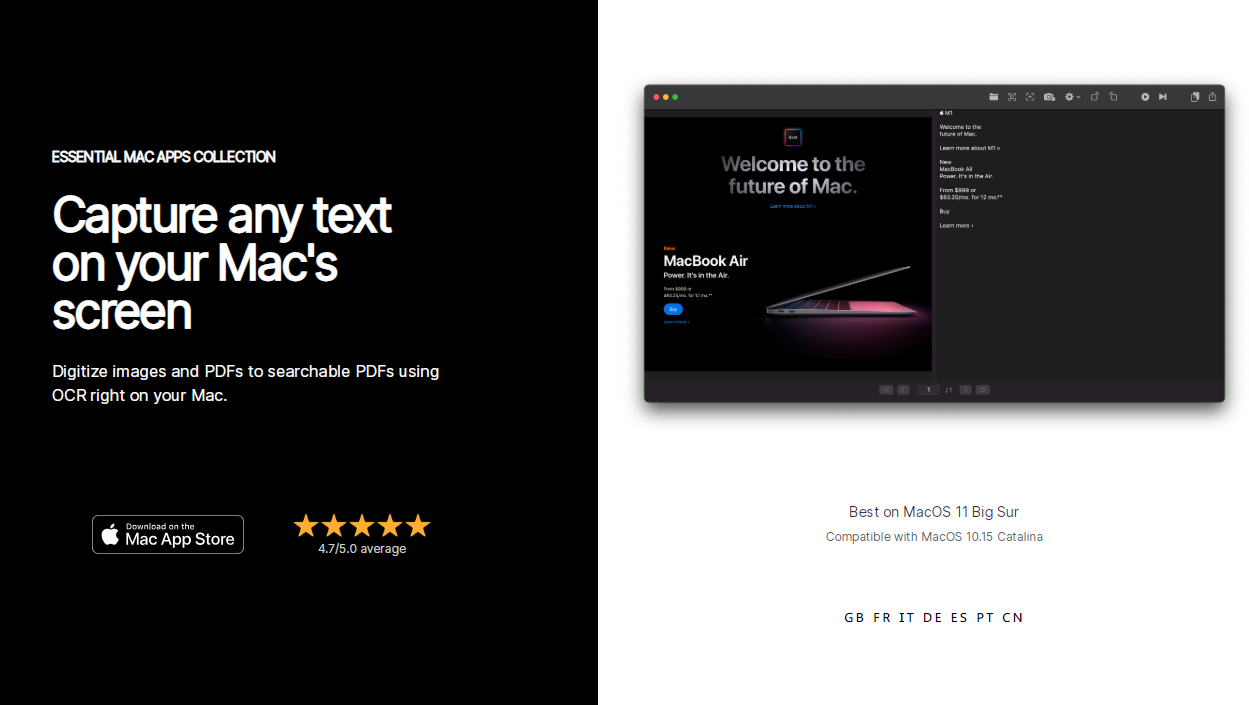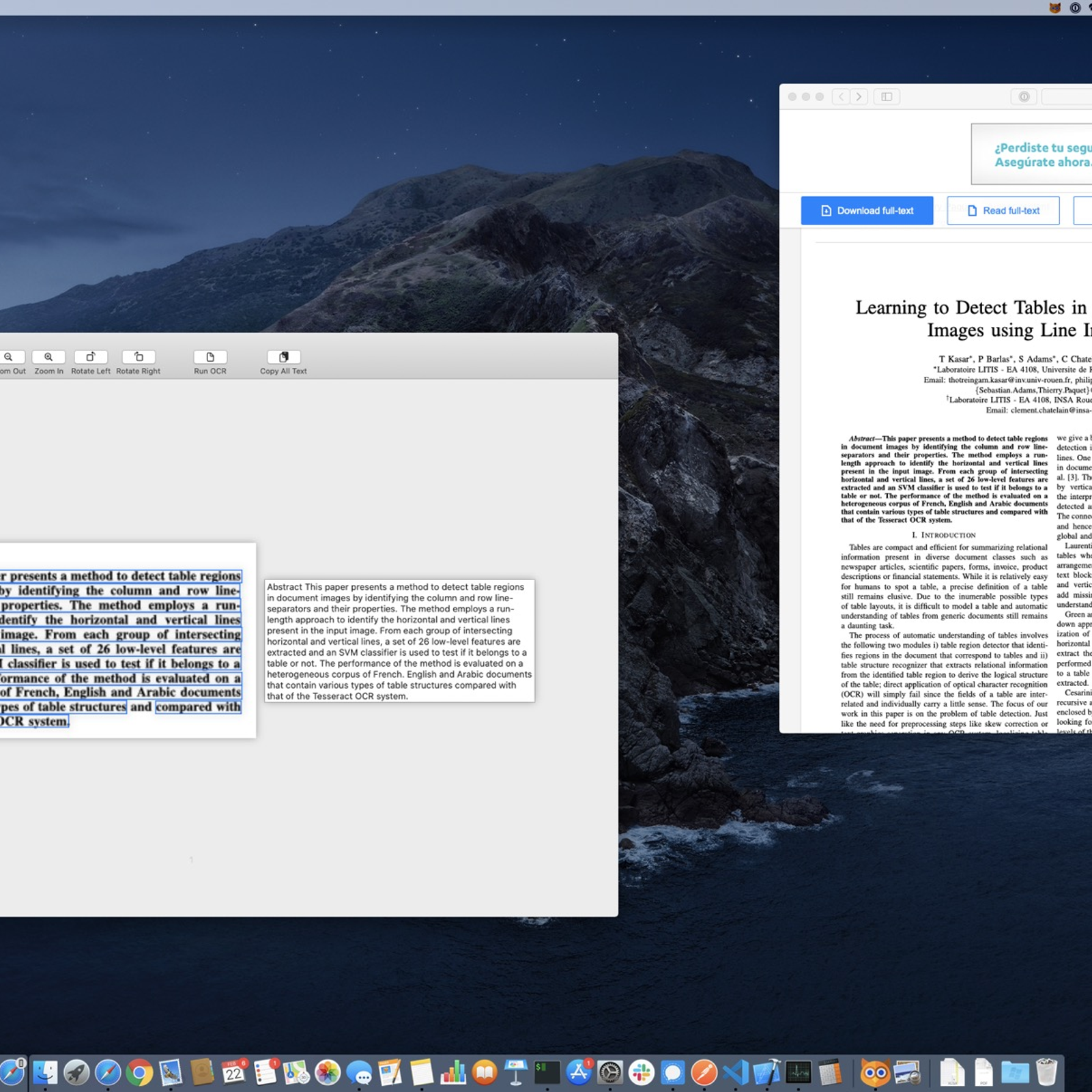OwlOCR offers simple optical character recognition of text in PDF files, images or on-screen and converts that to plain text. All conversion is done securely on-device - none of the data are sent to third-party services in the cloud as most applications do. Same problem domain as in action extensions, but didn't really see specific answer there. Also, I need to have a UI for my app, so removing UI (the one I provide) isn't really an option. OwlOCR offers simple optical character recognition of text in PDF files, images or on-screen and converts that to plain text. All conversion is done securely on-device - none of your images or files are sent to third-party services in the cloud as most applications do. MAU went down briefly after the crazy days in late 2020 where lots of people tried the app and for some of them it didn't stick of course. I turned lockdown into a side project and why you should too (owlocr.com) 2 points by frankbyte 89 days ago past Show HN: New website for a Mac screen text recognizer ( owlocr.com ).
Digitize images and PDFs to searchable PDFs using OCR right on your Mac.

How does it work?

The processing is done right on your Mac for near instantenous results.
Privacy secured
The text recognition algorithm that is used has been developed by Apple and is a part of your MacOS operating system and is only run on your device.
We never ask for or require any of your personal information or your data.

Core
- Unlimited high quality text recognition on-device securely and incredibly fast
- Grab a screen area for instant OCR and results copied to clipboard
- Grab multiple areas of your screen for instant OCR and concatenated results copied to clipboard
- Use Finder Extensions to trigger main use cases right from Finder
- Drag and drop documents to the app to convert to text
- OCR page-by-page in multi-page documents
- Take a photo or scan documents with your iOS device, directly from the app
- Export searchable PDFs
- Export OCR results to text files
- Custom dictionary
- Line spacing and word wrapping options
- Keyboard shortcut Cmd + F1 (configurable) for a screen grab
- Keyboard shortcut Cmd + F2 (configurable) for multiple screen grabs
- Notifications on OCR completion
- Input filetypes supported: PDF, PNG, JPEG, GIF, HEIC
- Language support under MacOS 11: English, French, Italian, German, Spanish, Portuguese, Traditional Chinese and Simplified Chinese.
- Language support under MacOS 10.15: English.
- Many customization options like Menu Bar -only mode, screenshot sounds, storage directories and more
- Apple M1, Dark Mode and MacOS Big Sur support
Pro
- All Core Features
- Batch OCR multi-page PDFs or multiple images files in a single fast run, using all your CPU cores
- Batch process multiple files in a single go right from Finder using Finder Extensions
- Use multiple screenshot feature to capture up to 20 concatenated screenshots
- Configure post-processing rules for Find/Replace behaviour and Smart Quotes substitution
- Karma boost for supporting indie Mac apps
No sign-up required.
- < Previous
- Next >
College of Arts and Letters Posters
Title
Presenter and Co-Authors
College
College of Arts & Letters
Department

English
Program
Applied Linguistics
Publication Date
4-2021
DOI
0000-0002-6942-6689 (McCullough)
Abstract
Ladino (or Judeo-Spanish) is a Diasporic Jewish language spoken by Sephardi Jews. There is little existing scholarly research on Ladino, nor does it have many language learning materials. These two factors compelled me to create the Aki Yerushalayim Corpus. The initial Aki Yerushalayim Corpus of Modern Written Ladino (currently ~7,000 words) was not created to act as a reference corpus of Modern Ladino. Rather, it was created to study the composition of Ladino prose and demonstrate the utility of this type project in the subdiscipline of language documentation. In addition, the project’s focus on cultural essays and narrative prose allow for insights into how Ladino writers construct their identities through word choice.
The research questions that directed the creation of the corpus are as follows: 1. What substrata feature most prominently in the Ladino lexicon? 2. Do the borrowed words belong to a particular semantic domain? 3. What parts of speech are most/least frequently borrowed?
To address and answer these questions, the gathered texts were first scanned with an optical character recognition software (OwlOCR) before being proofread for any mistakes. They were then tagged for Part of Speech and for language of origin and run through a concordancer (AntConc).
From this brief glimpse at Ladino prose in the late 20th and early 21st centuries, the results are as expected: the language is Spanish-based, and the most frequently-used substrata are Biblical Hebrew and Turkish, primarily used for religious and secular/cultural words, respectively. This pilot gives a snapshot into how authors represent their identity as Sephardi Jews in both cultural essays and narrative prose, and further study of the distribution of these loanwords will allow linguists to understand how language contact and a speech community’s history can provide context that illuminates which loanwords are most frequently adopted and why that may be.
Disciplines
Applied Linguistics | Jewish Studies
Files
Recommended Citation
McCullough, Rachel, 'The Aki Yerushalayim Corpus: A Study of Loanwords in Ladino' (2021). College of Arts and Letters Posters. 5.
https://digitalcommons.odu.edu/gradposters2021_artsletters/5
DOWNLOADS
Since April 01, 2021
Included in
Owlcrate
Applied Linguistics Commons, Jewish Studies Commons
Owlcorn Hatchimal
COinS